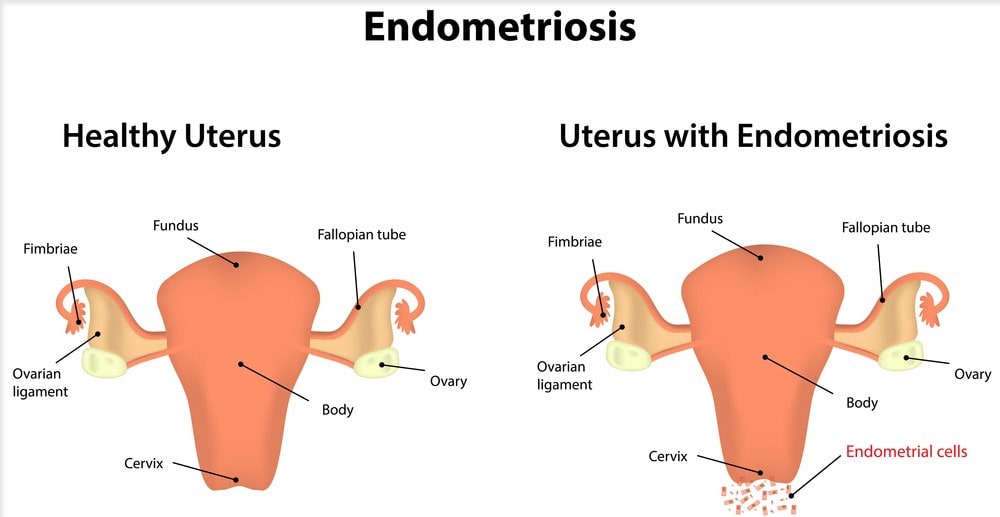Endometrios Treatment
What is Endometriosis?
The inner lining of the uterus is called endometrium. This tissue sheds off each month during the menstrual cycle. The abnormal growth of endometrial tissue outside the uterus is called endometriosis. In endometriosis the tissues develop into nodules, lesions, cysts or implants. The most common location of endometrial growth is ovaries, fallopian tube, outer surface of the uterus, the bladder and the lining of the pelvic cavity.
Endometrial growths are generally benign. Unlike the endometrial lining of the uterus the endometrial growth outside the uterus do not shed. This results in internal bleeding, adhesion and inflammation.
There are 20 types of vaginal disorders mentioned in Charaka Samhita. There no direct description of endometriosis. According to Madhava Nidanam yoni kanda is related to endometriosis. The clinical feature of yoni kanda is similar to that of endometriosis.
What Is Endometrial Cyst?
If the endometrial tissue gets to your ovaries a cyst is formed. This is called endometrial cyst. The endometrial cyst may be in one each of the ovaries. The size of a cyst is less than 2 inches, which may grow up to 8 inches. Such cyst may cause chronic pelvic pain, infertility, hinders the ovarian function and the risk of ovarian cancer is higher.
What Are the Symptoms of Endometriosis
The symptoms of endometriosis vary from each woman. The signs of endometriosis may vary from mild, moderate to severe. One may experience severe pain even if the degree of condition is low and mild pain when the severity of the disease is high.
The most common endometriosis symptoms in female is pelvic pain. Along with it the symptoms includes-
– Painful periods
– Pain in the lower abdomen during periods
– Cramps around menstruation
– Heavy menstrual bleeding
– Low back pain
– Infertility
– Heavy menstrual flow
– Pain during sexual intercourse
– Blood in stool or urine
– Fatigue
– Nausea and vomiting
In some women the disease is asymptomatic hence it is advised to have a regular gynecological examination.
What Is the Main Cause of Endometriosis?
According to Ayurveda any chronic disease is a result of accumulation of toxins. In endometriosis the toxins are accumulated in the reproductive tissue. As we all know that diseases occur due to imbalance of ‘tridoshas’ the governing factor of body. Endometriosis is kapha problem and may also be considered pitta problem because of the inflammatory nature of the disease.
The exact cause of endometriosis is not known. However there are certain theories that explain the occurrence of endometriosis. The back flow of menstrual blood to the fallopian tube and later into pelvic cavity may give rise to endometriosis. Another theory suggests the transportation of endometrial cells out of the uterus through the lymphatic system. Likewise there are many more theories but none is scientifically proven.
Some of the possible causes may be-
1) Problem with menstrual flow- retrograde menstrual flow may cause endometriosis.
2) Genetic factors- it may be inherited.
3) Immune system- a weak immune system may fail to shed endometrial tissue growing outside the uterus.
4) Estrogen hormone- is said to increase the chances of endometriosis.
5) In surgery such as C-section endometrial tissues has been found in abdominal scars.
Types of Endometriosis
There are 4 main types of endometriosis depending upon the affected area of abdomen.
1) Endometriomas- These are also called chocolate cysts. It appears in different parts of abdomen but commonly found in ovaries.
2) Superficial peritoneal endometriosis- in this the endometrial tissues attaches to the peritoneum. It is the least severe form.
3) Deeply infiltrating endometriosis- in this the endometrial tissues invade the ovaries, rectum, bladder and bowels.
4) Abdominal wall endometriosis- in this endometrial tissue grow on the abdominal wall.
What Are the Stages of Endometriosis
There are four stages of endometriosis.
1) Minimal- small lesions and shallow endometrial implants on the ovary. There may be inflammation in or around the pelvic area.
2) Mild- it involves mild or light lesions and shallow implants on an ovary and pelvic lining.
3) Moderate- it involves deep implants on the ovary and pelvic lining with one or more than one lesion.
4) Severe- it involves deep implants on the ovaries and pelvic lining. There may be presence of lesions on the fallopian tubes and bowels.
Endometriosis Tests
If you come across any of the symptoms of endometriosis, consult your doctor. The following endometriosis tests is done for diagnosis.
1) Pelvic exam- if there is large cyst it can be felt during the pelvic exam.
2) Ultrasound- it is used to check the ovarian cysts from endometriosis.
3) Magnetic resonance imaging is another common test that gives a picture of the inside of your body.
4) Laparoscopy- it enables the doctor to look the endometriosis tissue.
Endometriosis Test at Home
It usually takes very long time for a woman to know she is suffering from endometriosis. There is research going on and some have also come up with the home test. These test are not into practice yet. Thus it is recommended to visit a doctor for endometriosis test.
Endometrial test cost depends upon the technique being used to diagnose the disease.
What Is the Treatment for Endometriosis
Endometriosis treatment involves use of birth control pills, pain medication, hormonal birth control and other medication. It may also be treated through laparoscopic surgery.
Ayurvedic Treatment for Endometriosis
Endometriosis is a chronic disease that results from the accumulation of toxins due to poor nutrition, improper digestion and vitiated doshas. Hence the line of treatment is to correct the imbalance and eliminate the toxins.
Shodhana therapy in Ayurveda is a detoxification treatment that eliminates the toxins and balances the doshas. Therefore panchakarma is administered along with correcting the digestive system. Panchakarma therapy regularizes apana vayu, detoxifies pitta dosha and balances the kapha dosha.
Nutritious diet that is easily digested with good amount of digestive herbs is the first step.
Daily ayurvedic oil massage with other treatment loosens the ama. The ama is collected from different parts of the body to the digestive system for elimination. It also helps in relieving stress and brings calmness to the mind.
Virechan (purgation)- it eliminates the toxins from the body with the help of decoction.
Basti karma- medicated enema is the best therapy for any vata related disorder. Uttara vasti acts on the endometrial receptors.
Abhyanga- enhances the blood circulation and improves the lymph circulation in their vessels.
Swedana- it is a medicated steam bath.
Udvartana- it releases toxins from lymphatic system.
Pizichil- warm herbal oil is slowly dripped on the body. There is a particular way of doing this massage. It is beneficial in cleaning the body tissues.
Ayurvedic treatment for endometriosis has shown promising results. It is always suggested to consult the skilled and experienced ayurvedic doctors for endometriosis.
Endometriosis Natural Treatment/Natural Treatment for Endometriosis
Some of the home remedies or natural treatment to control the symptoms are-
1) Heat- placing a hot water bottle or a heating pad on lower abdomen helps in relaxing the pelvic muscles and reduces the pain.
2) Pelvic massage- massage with medicated herbal oil reduces pain during periods associated with endometriosis.
3) Turmeric- it has anti-inflammatory properties and helps in preventing growth.
4) Dietary changes- dairy products, processed food, sugars, gluten etc are problematic foods. Minimizing the consumption of red meat and intake of fresh fruits and vegetables, whole grain improves the overall health.
5) Exercise- light workout releases a hormone that reduces pain.
6) Omega-3 fatty acid reduces inflammation.
Ayurvedic Medicines for Endometriosis
Most useful herbs and ayurvedic formulation are shatavari, ashoka, lodhra, arjuna, daruharidra, vidarikanda, chandraprabha vati, ashwagandharishta, triphala churna, gorakhmundi, abhrak bhasma, kanchnar guggulu, pradarantak lauh etc.
Ayurvedic treatment of endometriosis includes ayurvedic medicines and ayurvedic therapies. To get better result diet and lifestyle changes is necessary. A proper diet enhances the effect of medicines. Aasha Ayurveda in Delhi is considered most reliable endometriosis specialists.
Recent Blog Posts
Best Ayurvedic Doctor in Delhi – Dr. Chanchal Sharma
Best Ayurvedic Doctor in Delhi When discussing Ayurveda Doctors for…
Infertility Doctor in Lucknow – Dr. Chanchal Sharma
Infertility Doctor in Lucknow – Dr. Chanchal Sharma Dr. Chanchal…
Infertility Doctor in Pune | Best Fertility Clinic/Centre Near Me
Infertility Doctor in Pune | Fertility Clinic/Centre in Pune It’s…
Frequently Asked Questions
Ayurvedic approach is the best for endometriosis treatment. Ayurvedic herbal treatment reduces the pain, unblocks the channels, reduces the endometrial tissues outside the uterus and reduces inflammation. The treatment aims to eliminate the root cause of the condition. Panchakarma treatments are safe and effective in endometriosis. 1)Vamana or purgation with herbal medicine eliminates the toxins out of the body. 2)Abhyanga/snehana or massage – it enhances the lymphatic and blood circulation. 3)Swedana – it is a medicated steam bath. 4)Pizchil –it involves slow dripping of warm medicated oil on the body while doing massage. 5)Udvartana – the therapy eliminates the toxins from the lymphatic system. 6)Vasti chikitsa – it is the best therapy for pacifying vata dosha and the medicated enema is chosen as per the dosha. The method involves administration of medicated oil/ghee through the urethra, rectum and vaginal route. Uttara basti is the term used when the basti therapy is given through uterine and vaginal route. It is the best treatment for gynecological disorders especially in endometriosis-associated infertility.
The four stages of endometriosis are – 1) Minimal – the lesions are small and there are endometrial implants on your ovary. The around the pelvic cavity is inflamed. 2) Mild – the lesions are light and shallow implants are found on the ovary and the pelvic lining. 3) Moderate – it involves deep implants on the ovary and pelvic lining. 4) Severe – there are deep implants on the ovary and pelvic lining. The lesions may appear on the fallopian tubes and bowels.
Endometriosis can be diagnosed through pelvic examination, ultrasound, magnetic resonance imaging and laparoscopy.
The endometriosis test cost depends upon the diagnostic method used by your doctor.






